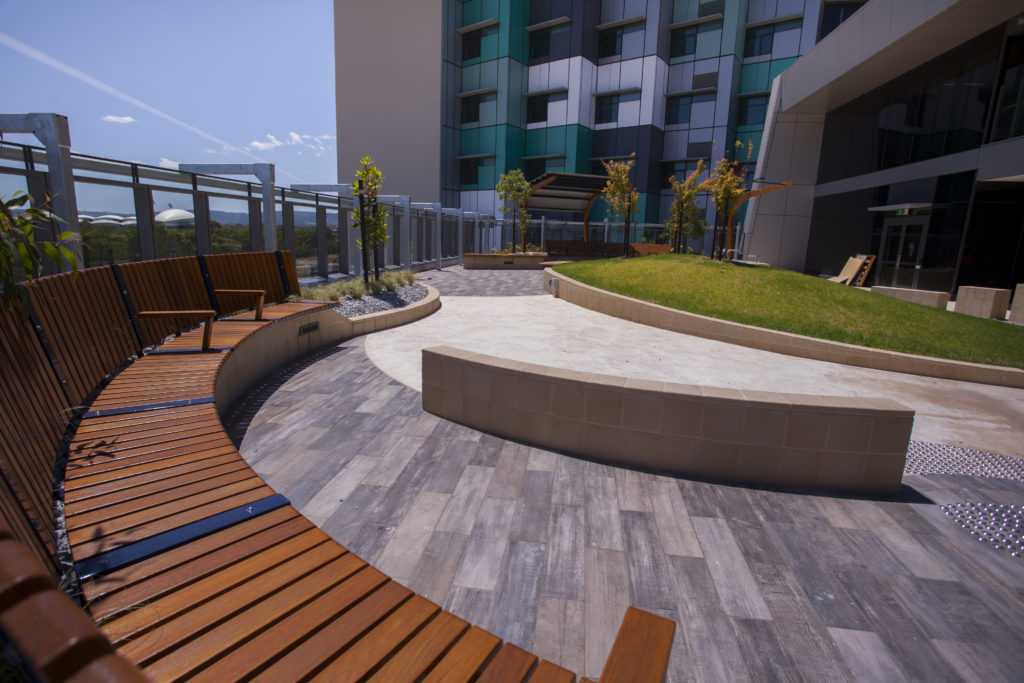Artworks, gardens act as signposts in Australia’s newest hospital
Arts
Unique art installations, gardens and courtyards are being used to help people find their way around Australia’s newest hospital.

Sign up to receive notifications about new stories in this category.
Thank you for subscribing to story notifications.

The $2.3 billion new Royal Adelaide Hospital (RAH), in the South Australian capital, officially opened last week and is the epicentre of the state’s health system. Reportedly the third most expensive building in the world, it replaces the old Royal Adelaide Hospital, which was established about 2km up North Terrace from the new site in 1856.
Silver Thomas Hanley led the design for the new 180,000sq m hospital, following a brief based on a model of care aimed to rejuvenate and disrupt the way health services are delivered in South Australia.
“The Royal Adelaide is intended to be the jewel in the crown of that restructured statewide service,” Silver Thomas Hanley Managing Director Ernest Girardi said.
“We re-engineered the whole concept of how a hospital works right down to the bedrooms.”

More than 25 South Australian artists were involved in creating works to be integrated into the hospital’s design. The artworks range from large photographs to add colour to otherwise sterile corridors, to nature-inspired graphics in lift lobbies and eye-catching sculptures in the landscaped courtyards.
The landscaped gardens and courtyards are located within two minutes of all 800 patient rooms, which also feature views of the surrounding parklands and windows that open.
Built in the northwestern corner of the Adelaide CBD overlooking the River Torrens and parklands, the hospital is part of the $3.6 billion Adelaide BioMed City.
Girardi said the hospital’s location on the edge of the city’s parklands was also integrated in the design.
“We took that theme further and integrated green spaces right through the facility – not only at ground level,” he said.

“I think that one of the key features if you walk through the facility are the courtyards, they are really quite stunning and what makes them uniquely South Australian is we were able to collaborate with a number of local artists to develop sculptures that have been installed into those courtyards and terraces.
“No courtyard is the same as another one so they serve as a way finding element to help people find their way around the facility.”
Girardi said there was a substantial evidence base that indicated that access to green spaces played a major role in helping patients recuperate.
“The staff are equally important,” he said.
“When staff are on it can be a pretty harrowing and intense environment to work in so we’ve provided lots of opportunities for them including green space where they can get away from that stressful environment and take the opportunity to gather their thoughts and relax.”

The hospital also has digital kiosks to help people navigate the building.
“There are a number of those at different entry points throughout the facility and they’re also designed to assist in way finding,” Girardi said.
“You can key in a destination and it will print out a little direction slip to help guide you through the facility.”
The 10-level hospital on a sloping 10-hectare site has its main entrance on Level 3. The narrow piece of land was once home to the city’s railyards. The design for the hospital was managed within the height restrictions posed by the flight path for the nearby Adelaide Airport.
The clinical and public components of the building are orientated towards the North Terrace or city CBD side of the building while the residential and inpatient components overlook the river and parklands from six triangular accommodation towers.
Passive solar design ensures natural light is maximised throughout the hospital, particularly in high-traffic areas and patient rooms. This means taking advantage of sunlight to help to minimise the need for artificial heating.
The hospital will also have natural ventilation systems to minimise the impact of pollutants generated either internally or externally.
The Royal Adelaide’s technology includes a fleet of 25 Automated Guided Vehicles (AGVs) to transport food, linen, waste and stores around the hospital; advanced tele-health facilities enabling staff to consult with colleagues and patients across the state; wireless technology and equipment with tracking capabilities so it can be located quickly and easily, and; the biggest pneumatic tube system in an Australian hospital, designed to speed up diagnosis and treatment by rapidly delivering critical supplies like blood samples and medicine.
The hospital’s long and narrow shape has allowed it to be laid out vertically rather than laterally, in a series of vertical clinical villages, which are accessed by three strategically located banks of lifts across the spine of the building.

“For instance, all the cancer services are not located on the one floor – you might not think that’s a good idea – we’ve located them on top of each other at the eastern end of the building,” Girardi said.
“At the lower level we’ve got the radiotherapy bunkers where people have radiation treatment, on the next level we have the outpatient services for consultations or chemotherapy treatment and on the upper levels we have the overnight accommodation for the oncology patients.
“So clinical movement is generally up or down over two or three levels rather than lateral east to west along the hospital’s long spine.”
Jump to next article



